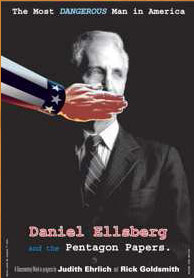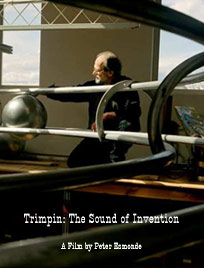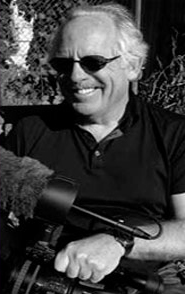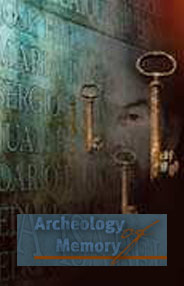Editorial Consulting
Films are stories. In documentary filmmaking, the story is often found during the editorial process. Even with a built-in storyline, coherence must be made from a combination of cinema verite, interviews, archival footage, animation, recreations, artwork and voice over. As filmmakers shoot more and more footage and the acceptance to first-tier festivals becomes more difficult every year, even veteran editors and filmmakers can find the process overwhelming. Particularly difficult is the struggle to maintain objectivity--especially after months or even years of editing--to stand outside the project as if seeing it for the very first time. Extensive experience editing both features and documentaries has given Michael a unique perspective:
Recent Projects
Here's what clients are saying about Michael's work, followed by a brief discussion of
the consulting process.
 The Most Dangerous Man in America: Daniel Ellsberg and the
Pentagon Papers, 92 mins
The Most Dangerous Man in America: Daniel Ellsberg and the
Pentagon Papers, 92 minsOfficial Website
Kovno Communications
Producer/Director: Judy Ehrlich & Rick Goldsmith
Festivals: Toronto, Film Forum
Consulting: 6 weeks
We hired Michael to consult on our documentary film last Spring. We spent 2 weeks with him in Moab,
and he continued to work for a month after we returned to Berkeley. Thanks to Michael,
our non-fiction film has the feel of a fiction political thriller. He took our good enough film and
made it sing. Michael is an editor and filmmaker with an extraordinary sense of storytelling and structure.
I didn't think he could wend his way thru the hundreds of hours of our material to find the gems, but
somehow he did, in very short order! He is also a fabulous arbiter between stubborn co-directors and
helped us find a third way which was better than either of our approaches. We resisted going to Moab
to work with Michael,because of the expense and time away from our base, but it was a very good decision.
It gave us the time to really focus on the film, as well as enjoy the incredible landscape while he worked
his magic. I highly recommend Michael as a consulting editor! --Producer/Director, Judith Ehrlich
Thanks for everything. I keep thinking how important it was that we got to you when we did. Your understanding of what was good, what was needed, what was the real meat, and your magic in crafting it and making it all work was invaluable, and it wouldn't be near the same film, or near as clear and as powerful without you. You're the best. --Producer/Director, Rick Goldsmith
 Trimpin: The Sound of Invention, 79 Mins.
Trimpin: The Sound of Invention, 79 Mins.Official Website
Participant/Observer Films
Producer/Director: Peter Esmonde
Festivals: SXSW, Silverdocs, London, Vancouver
Consulting: 2 weeks
Put simply, Michael is a brilliant editor and filmmaker. He has an extraordinary ability to integrate both the narrative and emotional potential of raw footage and rough cut sequences into a compelling story arc. Michael's understanding of narrative throughline is sophisticated and sharp -- yet tempered with a remarkable lyricism and sensitivity. It was a privilege to work with him, and I hope I'll have the opportunity again.--Producer/Director, Peter Esmonde
 From Ghost Town To Havana, Work-In-Progress
From Ghost Town To Havana, Work-In-Progress
PlayTwo Pictures
Producer/Director: Gene Corr
Consulting: 1 week.
Michael edited my (and Robert Hillmann's) feature documentary Waldo Salt: A Screenwriter's Journey. He did a brilliant job, resulting in the film's nomination for Best Documentary Feature by the Academy in 1991. Bob and I thank Michael's remarkable intelligence, passion, and skill (and our wisdom to have
chosen him) for that honor. I'd admired Michael's work for years (Amadeus) and marveled at his ability
to go back and forth between feature and documentary forms. After struggling for months to put
together a promo for my new documentary on what baseball means to kids growing up poor, I took the
job to Moab and Michael delivered again. After a week of working together, we came up with a piece
that hits all the right notes. Don't try this at home. Michael soaked up my vision and intention and then
turned a challenging concept into an imaginatively structured and cut piece that will be a great help in fundraising. And Moab's a stunning place to work. --Producer/Director, Gene Corr
 Archeology of Memory: Villa Grimaldi, 88 mins.
Archeology of Memory: Villa Grimaldi, 88 mins.
Official Website
Interfaze Productions
Producer/Director: Marilyn Mulford, Quique Cruz
Festivals: Mill Valley, Audience Award; Vancouver; Mendocino, Jury Award
Consulting/Editorial: 12 weeks.
I knew Michael from the work he'd done as writer and editor on "Freedom on My Mind, a film I'd co-produced and directed and which was nominated for an Academy Award and won the Best Documentary at Sundance. Needless to say, Michael did a fantastic job. So on my next film, “Archeology of Memory: Villa Grimaldi”, although my co-director Quique Cruz and I were pleased with many aspects of our rough cut, we felt it lacked an organizing structure and needed to reflect more of Quique's artistic struggle, which lay at the heart of the story. As a filmmaker himself, Michael was able to elegantly incorporate new elements and give us the poetic feeling we'd been after. He also gave the film a strong forward movement, not easy to do in a personal, reflective piece. Working in Moab away from our ordinary lives gave us a chance to concentrate on the film in ways we hadn't done before. And being in such a beautiful place was exhilarating. We worked hard, but we also took hikes in a magical landscape while Michael worked. A wonderful opportunity to ‘chill’ and ‘reflect’ on the work. After this experience, I would never hire anybody else. --Producer/Director, Marilyn Mulford
The Process
Films generally come to consulting either as an assembly or rough cut. For long-form projects, the process
takes a minimum of six weeks, with shows averaging between 10 to 16 weeks. It is an edit in miniature, a compressed, intense effort. In some cases,
work is done in tandem with the show's editor, and while each project brings a different challenge,
there are common elements.
